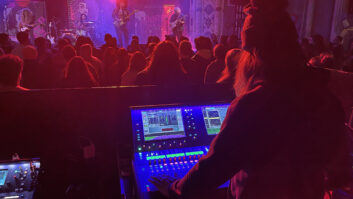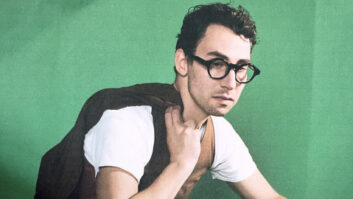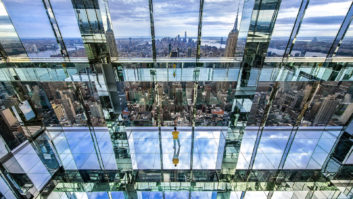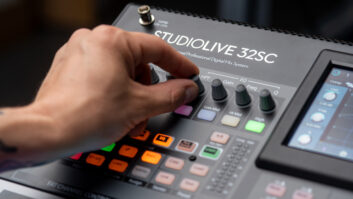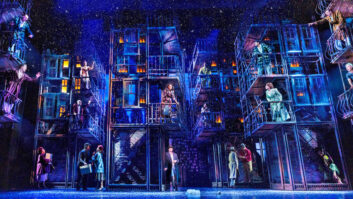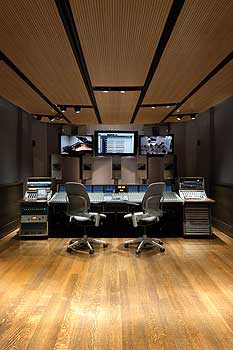
Those of us whose lives revolve around audio know our field has many gifts that keep on giving. One is the fact that there’s something new to learn every day while we track, mix, master, edit, overdub or perform 1,000 other sonic tasks.
Building on that concept in a big way is New York University’s remarkable new James L. Dolan Recording/Teaching complex (on this month’s cover), part of the Department of Music and Performing Arts Professions at NYU’s Steinhardt School of Culture, Education and Human Development. The name is a mouthful, but it’s worth remembering; this $6.5 million, 7,500-square-foot facility was built with the future of audio education in mind.
“The music technology program here is one of the oldest and largest in the country, with close to 200 majors in it,” says Robert Rowe, Vice Chair of NYU Steinhardt’s Department of Music and Performing Arts. “We want to instruct our students with an emphasis on research and the highest technology in practice.
“The audio field has progressed a great deal since we started 30 years ago,” he continues. “There are myriad job possibilities and students expect to be prepared, but we also want to exceed students’ expectations. Not just teach them ‘x, y and z’ and work in a studio, but blow their heads open to go beyond ‘z’—help them to imagine what the future will be because that’s what they’ll be living in.”
Designed by Walters Storyk Design Group and architectural firm Gensler, the Dolan complex occupies the entire sixth floor of 35 West 4th St. in the heart of Greenwich Village. The most obvious highlight is the control/classroom, which can host up to 25 students and houses a 48-channel SSL Duality console, Lipinski L707 and L150 (sub) speakers and the first Dangerous Music 10.2 surround installation in New York City. Adjacent to that space is a large and flexible live room, which can accommodate anything from a chamber music ensemble to a rock group. The floor also includes several research laboratories, offices, a conference/seminar room and a large iso/drum booth, while multiple windows and a full line of sight provide natural light throughout.
Three floor-to-ceiling steel building trusses presented WSDG co-principal John Storyk, his team and Gensler with a significant physical challenge. While vital to structural stability, the trusses necessitated a series of innovative design solutions to achieve NYU’s specific goals: maximum space optimization, use flexibility, room-to-room visual connectivity and adherence to the uncompromising truss configuration.
“The NYU Dolan complex was a demanding assignment on every level,” Storyk comments. “The trusses were particularly inconvenient, but beyond those inflexible parameters, NYU had an extremely dense design program that required the facility to accommodate teaching, lecturing, research, performance and recording missions all with their own technological support systems. Simultaneously, they needed to share a very specific physical footprint. The point that the completed studio is world-class in every sense of the word can’t be overemphasized. If an artist or producer were able to book a session date, they would have no idea they were working in a teaching environment. They would simply accept it as an amazing real-world recording studio.
“There’s a tricky balance here,” Storyk adds. “Many schools prefer to hold lectures in traditional classrooms or lecture hall environments, and control rooms are generally configured for smaller lab groups. NYU, however, wanted to accommodate a full class of 25 in the control room, immersing them in the actual production environment.
“This requirement resulted in an exceptionally long control room that affected room ratios and potentially could have had a negative impact on low-frequency behavior. After modeling the room, we designed accordingly, employing extensive membrane absorbers, which we positioned discretely throughout the room in ceilings and rear room corners. These adjustments address the modal imbalances and produced an extremely effective environment for NYU’s teaching criteria.”

In the James L. Dolan Recording/Teaching complex are, L-R: James L. Dolan, president and CEO of Cablevision; Kristin Dolan, senior VP of Cablevision Systems Corp.; WSDG co-principal John Storyk; Agnieszka Roginska, associate director of music technology; Tom Beyer, chief systems engineer/adjunct professor; and Robert Rowe, Vice Chair/director of music composition
Photo: Cheryl Fleming Photography
Less visually striking, but even more ambitious, is the adjoining Research Lab. Dedicated to 3-D audio experimentation, the small room—which can double as an iso booth—holds a reconfigurable grid outfitted with 16 Genelec speakers, two Genelec subs, and multichannel miking, tracking and playback options, as well as an extremely low (0.2-second) reverb time. Working within the lab, students have the optimal testing ground to create audio for advanced theater, multimedia presentations, forward-looking audio post situations and whatever else they care to dream up. Throughout the project, WSDG associate David Kotch collaborated with Masque Sound on technology selection and integration.
“The Research Lab is probably the purest expression of the Dolan complex’s underlying philosophy, which is to make things as flexible as possible to do whatever we think of,” Rowe says. “The room is probably the most diversified in the whole place: We terminated every possible network connection in its grid so you can capture audio, impulse responses, do surround. It’s a blank space, but outfitted with the most infrastructural support possible.”
Managing a project the size of NYU calls for studio design/construction coordination on the very largest scale, observes Joshua Morris, designer and project manager for WSDG. “Complex technical construction in New York City is just that: complicated,” he says. “Managing a project of this scale calls for an exceptionally high degree of studio design/construction coordination. The key is to ensure communication between the disciplines. Moreover, you have to know how best to route information and questions—how to efficiently frame an issue. Understanding the project hierarchy is critical to efficient communication.”
For the next wave of music and sound adventurers motivated enough to make it into NYU’s Steinhardt program, the Dolan complex is special in its capacity to keep the teachers feeling as excited as the students. “What we dreamed of is what we got,” Rowe sums up. “My greatest enthusiasm is that it will build a community. These students are used to being apart and in different buildings—now they’ll see each other several times a day, and I can’t overstate how much that proximity means. We had enough experience to know that this was the way to go, but most exciting to me is that I don’t know what’s going to happen next.”
David Weiss is the founder/editor of New York–based audio Website/newsletter Sonic Scoop.

